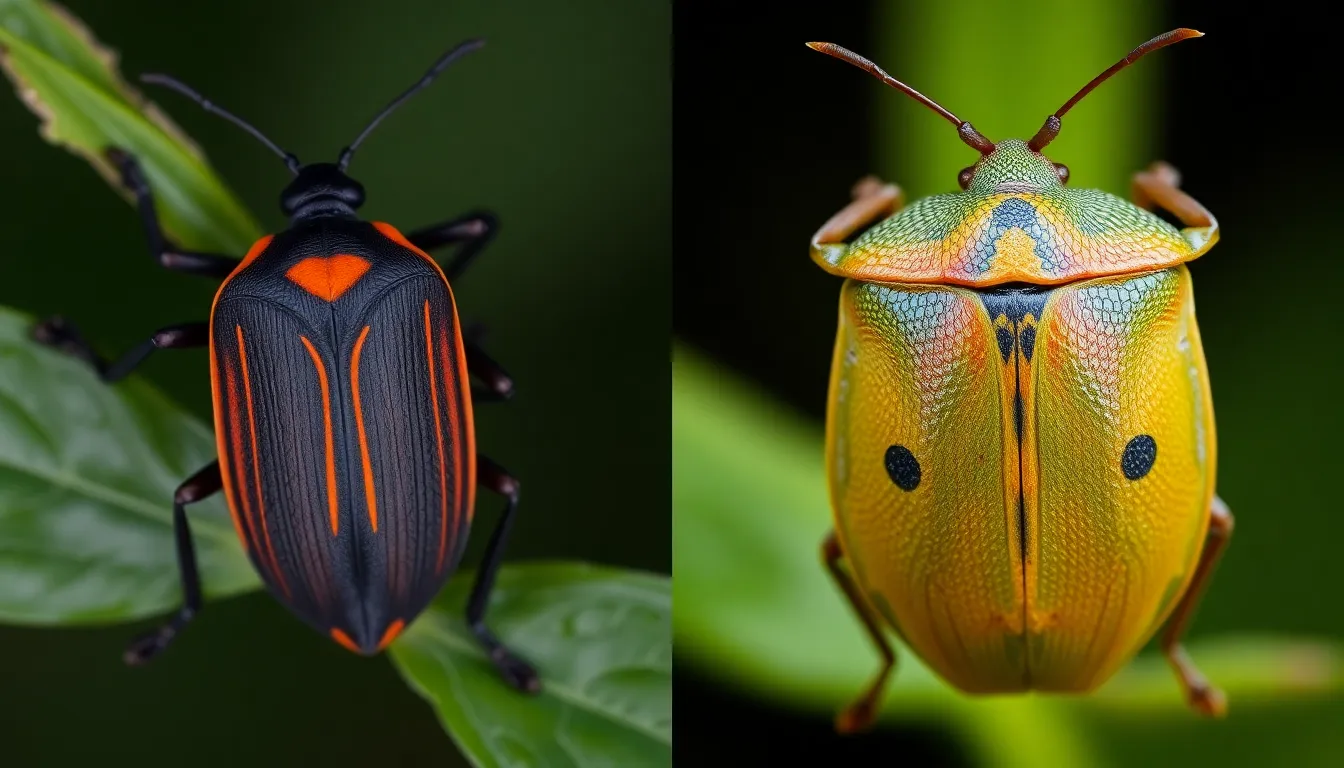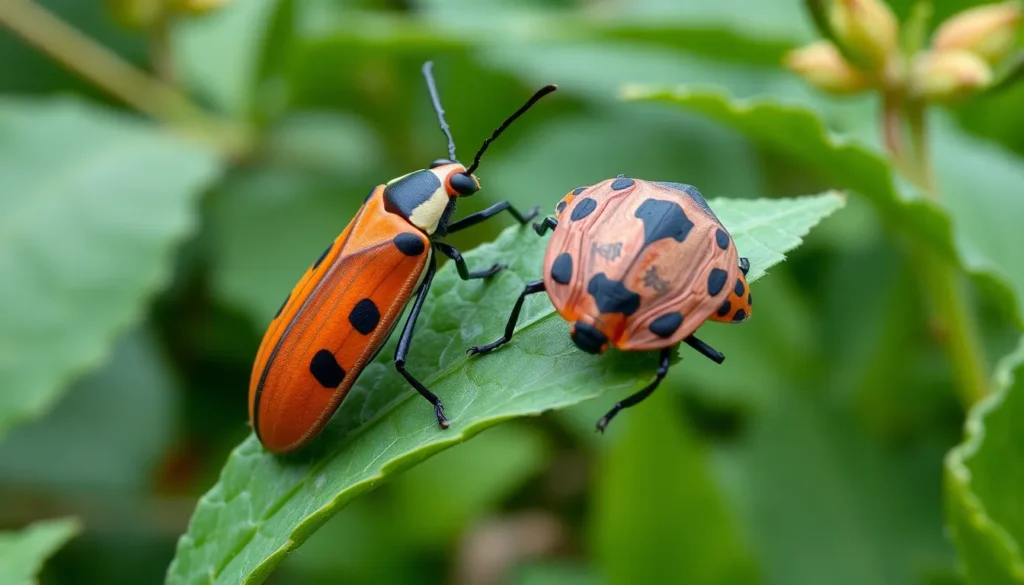Table of Contents
ToggleIn the world of insects, the kissing bug and stink bug often capture attention for their unique characteristics and behaviors. Both pests can invade homes and gardens, but they belong to different families and pose varying threats to humans and agriculture. Understanding the differences between these two bugs can help homeowners and gardeners protect their spaces more effectively.
Kissing bugs, known for their distinctive bite and potential to transmit Chagas disease, are often found in warmer climates. On the other hand, stink bugs are notorious for their unpleasant odor when threatened. By exploring the key differences between these insects, readers can gain valuable insights into their habits and how to manage them in their environment.
Overview of Kissing Bugs and Stink Bugs
Kissing bugs and stink bugs represent distinct insect categories with different characteristics and behaviors. Understanding their definitions aids in effective pest management.
Definition of Kissing Bugs
Kissing bugs, part of the Triatominae subfamily, are known for their elongated bodies and distinctive markings. They typically measure between 1 to 1.5 inches in length and exhibit a characteristic pattern of red or orange stripes on their abdomen. These insects primarily feed on the blood of mammals, including humans, using their sharp mouthparts. Kissing bugs are infamous for potentially transmitting Chagas disease, especially prevalent in regions like Latin America, where they thrive in warmer climates.
Definition of Stink Bugs
Stink bugs belong to the Pentatomidae family, marked by a shield-shaped body that ranges from about 0.5 to 1 inch in length. They display a varied color palette, including green, brown, or gray, depending on the species. Known for their ability to emit a foul odor as a defense mechanism, stink bugs primarily feed on plant materials, extracting fluids from crops and ornamental plants. Their invasion tends to occur in the fall, seeking shelter in homes to escape colder temperatures.
Physical Characteristics

Kissing bugs and stink bugs exhibit distinct physical traits that aid in their identification. Understanding these differences assists homeowners in recognizing each pest.
Appearance of Kissing Bugs
Kissing bugs feature elongated, oval-shaped bodies that typically range from 1 to 1.5 inches in length. Their coloration often varies, displaying shades of brown or black, complemented by striking red or orange stripes along the edges. Kissing bugs possess long, slender legs and prominent antennae that consist of four segments. Their wide, flat heads house elongated mouthparts, designed for piercing and sucking.
Appearance of Stink Bugs
Stink bugs boast a characteristic shield-shaped body, generally measuring between 0.5 to 1 inch long. Their coloration ranges from green to brown, with some species exhibiting intricate patterns. Stink bugs have short, stout legs and a distinctly rounded posterior, contributing to their unique silhouette. Additionally, their smell glands release a pungent odor when threatened, thus serving as a defense mechanism against predators.
Habitats and Distribution
Kissing bugs and stink bugs inhabit different environments that influence their behaviors and interactions with humans.
Where Kissing Bugs Are Found
Kissing bugs thrive in warm and humid regions. They primarily inhabit areas like:
- Southern United States: States including Texas and Arizona provide ideal conditions.
- Latin America: Countries such as Mexico and Argentina host many species.
- Rural Areas: Kissing bugs often shelter in outdoor structures, agriculture, and nature, particularly near animal dwellings.
Kissing bugs prefer to stay in places with ample hiding spots, such as woodpiles and cracks in walls. They may enter homes in search of hosts during the nighttime due to their nocturnal habits.
Where Stink Bugs Are Found
Stink bugs occupy a variety of habitats, which provide them with food sources. Their preferred locations include:
- Fields and Gardens: Stink bugs often gather in crops like soybeans and corn.
- Urban Areas: They frequently invade homes, especially during the fall, seeking warmth and shelter as outdoor temperatures drop.
- Woodlands and Forests: Many species live in wooded areas where they can find plants to feed on.
Stink bugs inhabit a range of environments and tend to cluster during colder months or after heavy rains, making their appearance in residential areas more likely during these times.
Behavior and Diet
Kissing bugs and stink bugs exhibit distinct behaviors and dietary preferences that differentiate them in the insect world.
Feeding Habits of Kissing Bugs
Kissing bugs primarily feed on the blood of their hosts, often becoming active at night. They utilize specialized mouthparts to pierce the skin of mammals, including humans, pets, and wild animals. Kissing bugs are predominantly found in rural areas, where they often hide in animal nests or within crevices in structures. Their feeding process can last anywhere from 20 minutes to several hours. After a meal, they typically retreat to their hiding places to digest their food.
Feeding Habits of Stink Bugs
Stink bugs primarily feed on a wide variety of plant materials, including fruits, vegetables, and ornamental plants. They use their piercing mouthparts to extract sap and nutrients, causing damage to plants in the process. Stink bugs are known to aggregate in large numbers, especially during the fall as they search for shelter. Their feeding habits can lead to significant agricultural damage, making them a concern for farmers and gardeners alike. Stink bugs typically feed during the day, although they can also be active at night.
Impact on Humans and Agriculture
Kissing bugs and stink bugs pose distinct impacts on humans and agriculture, affecting health and economic stability in various ways.
Health Risks Associated with Kissing Bugs
Kissing bugs are vectors for Chagas disease, a significant health concern in regions where the insects thrive. This disease, caused by the parasite Trypanosoma cruzi, can result in severe cardiac and gastrointestinal complications if left untreated. Infection occurs when kissing bugs bite and defecate on or near a person’s skin, and the parasite enters through breaks in the skin or mucous membranes. Approximately 300,000 people in the United States are infected, particularly in southern states. Awareness of these health risks is crucial for those living in or visiting endemic areas, as early diagnosis and treatment can significantly improve outcomes.
Economic Impact of Stink Bugs
Stink bugs inflict considerable economic damage by feeding on a wide range of crops, which compromises agricultural productivity and results in financial losses for farmers. They damage fruits, vegetables, and field crops by extracting sap, leading to blemished produce and decreased yields. In 2010, damage from the brown marmorated stink bug alone was estimated at over $37 million across the Mid-Atlantic states. Their tendency to aggregate, especially in the fall, exacerbates this issue, as large populations can swiftly overwhelm fields and gardens. Farmers and agricultural businesses often incur additional costs for pest management strategies, further impacting the economy.
Comparison of Kissing Bug vs Stink Bug
Kissing bugs and stink bugs exhibit distinct traits that set them apart, yet they share some common characteristics as well. Understanding these differences and similarities facilitates effective pest management.
Key Differences
- Classification: Kissing bugs belong to the Triatominae subfamily, while stink bugs are part of the Pentatomidae family.
- Physical Appearance: Kissing bugs feature elongated, oval-shaped bodies ranging from 1 to 1.5 inches in length, with brown or black coloration and prominent red or orange stripes. Stink bugs present with a shield-shaped body measuring 0.5 to 1 inch long, displaying colors from green to brown along with intricate patterns.
- Feeding Habits: Kissing bugs primarily feed on the blood of mammals, including humans, using specialized mouthparts to pierce skin. Stink bugs consume various plant materials, extracting sap and nutrients from fruits and vegetables.
- Health Risk: Kissing bugs are vectors for Chagas disease, posing health risks in endemic areas, with around 300,000 individuals infected in the U.S. Stink bugs, while not harmful to humans, cause economic damage, with the brown marmorated stink bug alone costing over $37 million in agricultural losses in 2010.
- Behavior: Kissing bugs are nocturnal, actively seeking hosts at night, while stink bugs are diurnal, feeding primarily during the day and aggregating in large numbers, especially in the fall.
Similarities Between the Two
- Habitat Preferences: Both insects invade homes seeking shelter, particularly during colder months; kissing bugs prefer warm, humid regions while stink bugs occupy diverse environments including gardens and urban areas.
- Lifecycle: Kissing bugs and stink bugs undergo similar life stages, including egg, nymph, and adult forms, contributing to their population dynamics.
- Pest Nature: Both types of bugs are considered pests, impacting human habitats and agricultural practices, necessitating effective management strategies.
- Use of Mouthparts: Kissing bugs and stink bugs possess specialized mouthparts designed for piercing; this adaptation aids in their feeding strategies, whether it be blood or plant sap.
Understanding the differences between kissing bugs and stink bugs is crucial for homeowners and gardeners alike. Kissing bugs pose health risks due to their role in transmitting Chagas disease, while stink bugs are primarily an agricultural nuisance. Their distinct physical characteristics and behaviors make identification easier, allowing for more effective pest management.
Awareness of their habitats and feeding habits can help prevent unwanted invasions. By taking proactive measures, individuals can safeguard their homes and gardens from these pests. Whether dealing with the potential health concerns of kissing bugs or the agricultural damage caused by stink bugs, knowledge is the first step toward effective control.




